
Congratulations to the newest cohort of Jacobs Institute Innovators!
This semester’s cohort of the Jacobs Institute Innovation Catalyst Program was selected from a competitive pool of applicants for their creative intelligence and innovative potential, and are now benefiting from sponsorship and mentorship to transform their projects into fruition.
The Spring 2025 Cohort features 11 projects and 33 students, with five teams awarded the Ignite grant ($2000) for more advanced projects, and 6 teams receiving the Spark grant ($500) for early stage project concepts. This semester’s participants include students from undergraduate, master’s, and PhD programs.
Our Innovation Catalyst Program grants each student a Maker Pass to utilize any resources and machines within our Makerspace, including mentorship from our Design Specialists, Student Advisory Board, Design Fellows, and other experts.
Winners of the Ignite and Spark Grants will showcase their projects and accomplishments during the Spring Jacobs Design Showcase on Thursday, May 8th, from 12-1:30 PM. (RSVP here.)
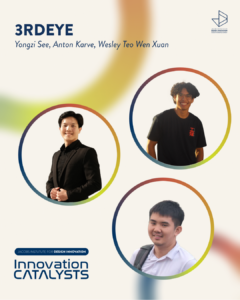
3RDEYE: Yongzi See (Economics ‘26), Anton Rahul Obordo Karve (Immersive Programme in Entrepreneurship ‘27), Wesley Teo Wen Xuan (Immersive Programme in Entrepreneurship ‘27)
Designing and fabricating an automotive industry-standard, 77GHz bandwidth radar module that is compatible with easily accessible microcontroller units such as the Espressif and Arduino family. This project was started with the eventual aim of creating a cost-effective bicycle safety radar system.
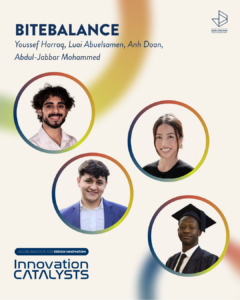
BiteBalance: Youssef Harraq (MTM ‘25), Luai Abuelsamen (MEng ‘25), Anh Doan (MTM ‘25), Abdul-Jabbar Mohammed (Bioengineering MEng ‘25)
We provide a non-invasive medical device designed to help patients who grind their teeth at night. Our device detects bruxism episodes in real-time and stimulates the nervous system to trigger a systematic relaxation response. By addressing the root cause (an unbalanced nervous system) our integrative solution offers a targeted, effective approach to treating bruxism and improving overall well-being.
 Dr. Octopus Project: Generalized “Actuator Gain” Prosthetic with Non-Limbic EMG Control: Aarav Goel (B.S. Mechanical Engineering ‘25), Parth Behani (B.S. Mechanical Engineering ‘25), Sohan Jayanth (B.S. Mechanical Engineering ‘25), Charles Gordon (BA, CS 2025), Abinaya Dinesh (CS + Conservation Resource Studies ‘26)
Dr. Octopus Project: Generalized “Actuator Gain” Prosthetic with Non-Limbic EMG Control: Aarav Goel (B.S. Mechanical Engineering ‘25), Parth Behani (B.S. Mechanical Engineering ‘25), Sohan Jayanth (B.S. Mechanical Engineering ‘25), Charles Gordon (BA, CS 2025), Abinaya Dinesh (CS + Conservation Resource Studies ‘26)
The Dr. Octopus system contains a mobile wearable suit housing robotic arms, controlled by mappings from EMG signals from a set of muscles that are non-limbic. Information such as the angle of extensions of the arm and signals from potential pressure sensors on the gripper for the robotic arms are encoded and transmitted to a network of piezoelectric buzzers that provided haptic feedback on the user’s skin, providing feedback and awareness on how the users EMG signals are affecting the robotic arms’ movements.
 Dual Use Simulator: Akshat Kumar (Mechanical Engineering ‘25), Pratik Jitendra (Mechanical Engineering ‘25), Smit Bhagat (Mechanical Engineering ‘25), Aashray Manchanda (Mechanical Engineering ‘25)
Dual Use Simulator: Akshat Kumar (Mechanical Engineering ‘25), Pratik Jitendra (Mechanical Engineering ‘25), Smit Bhagat (Mechanical Engineering ‘25), Aashray Manchanda (Mechanical Engineering ‘25)
The dual use simulator is a two in one assembly that allows the user to have a simulation rig for both racing and flight applications. Commercial solutions satisfy only one form of simulation and can be very costly to the end user; the goal of this project is to develop a capable yet affordable solution that satisfy both needs and be utilized by relevant clubs at Berkeley for possible future simulators.
 Machine Learning-Driven Inverse Design of Voxelated Soft Shape-Morphing Structures: Yuna Yoo (PhD Mechanical Engineering ‘28) , Albert Leong (B.S. Mechanical Engineering ‘26), Sunga Kim (B.S. Material Science and Engineering ‘28), Minh Nguyen (B.S. Mechanical Engineering 26), Anna Linn (B.S. Chemical Engineering ‘26)
Machine Learning-Driven Inverse Design of Voxelated Soft Shape-Morphing Structures: Yuna Yoo (PhD Mechanical Engineering ‘28) , Albert Leong (B.S. Mechanical Engineering ‘26), Sunga Kim (B.S. Material Science and Engineering ‘28), Minh Nguyen (B.S. Mechanical Engineering 26), Anna Linn (B.S. Chemical Engineering ‘26)
This research introduces an efficient inverse design method for 3D shape-morphing actuators, addressing the challenges of achieving complex target shapes. By dividing the input design space into voxels and using machine learning algorithms, the approach optimizes material arrangements to enable desired morphing behaviors, opening new possibilities for applications in robotics and biomedical engineering.
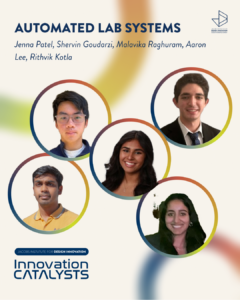 Automated Lab Systems: Jenna Patel (B.S. Bioengineering ‘27), Shervin Goudarzi (EECS ‘27), Malavika Raghuram (MCB ‘26), Aaron Lee (Mechanical Engineering ‘27), Rithvik Kotla (Bioengineering ‘27)
Automated Lab Systems: Jenna Patel (B.S. Bioengineering ‘27), Shervin Goudarzi (EECS ‘27), Malavika Raghuram (MCB ‘26), Aaron Lee (Mechanical Engineering ‘27), Rithvik Kotla (Bioengineering ‘27)
Automated Lab Systems is a project within Neurotech@Berkeley aimed at designing, developing, and implementing budget-friendly automated imaging, media replacement, and CO2 incubator system. These devices will be used for storing, culturing, and growing cortical neural cells for the Wetware committee allowing for remote-controlled maintaining of these neurons when no one is present.
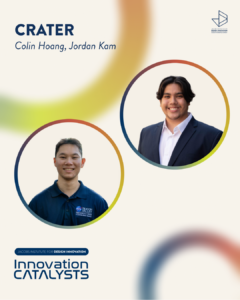 CRATER: A Regolith Collection Robot for In-Situ Manufacturing of Lightweight Meta-Materials: Colin Hoang (B.S. Aerospace Engineering ‘26), Jordan Kam (B.S. Aerospace Engineering ‘26)
CRATER: A Regolith Collection Robot for In-Situ Manufacturing of Lightweight Meta-Materials: Colin Hoang (B.S. Aerospace Engineering ‘26), Jordan Kam (B.S. Aerospace Engineering ‘26)
CRATER describes a regolith collection robot compatible with the NASA Ames ARMADAS robotic system for lunar manufacturing and construction. The robot is meant to collaborate with existing robots to collect and transport regolith for in-situ processing and manufacturing of metamaterials on the lunar surface.
 Exploration of Hierarchical Architectural Designs for Flexible Protective Devices: Ailin Chen (PhD ME ‘26)
Exploration of Hierarchical Architectural Designs for Flexible Protective Devices: Ailin Chen (PhD ME ‘26)
This project explores hierarchical architectural designs inspired by nature to develop flexible protective devices with enhanced impact resistance and durability. Using advanced 3D printing technologies, the work addresses key challenges such as weak bonding between stiff and soft materials and limited energy dissipation mechanisms. The goal is to create lightweight, resilient systems that balance protection, mobility, and functionality for diverse protective applications.
 Fungi Footwear: Selene Jiang-Qin (Intended Cognitive Science / Integrated Biology ‘28)
Fungi Footwear: Selene Jiang-Qin (Intended Cognitive Science / Integrated Biology ‘28)
Fungi Footwear seeks to create a biodegradable clog-style shoe with mycelium leather and hardwood. It reconnects wearers to nature and the cycle of growth and decomposition.
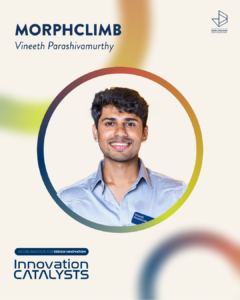 MorphClimb: Vineeth Parashivamurthy (MEng, Mechanical Engineering ‘25)
MorphClimb: Vineeth Parashivamurthy (MEng, Mechanical Engineering ‘25)
MorphClimb is a cutting-edge climbing robot designed to address critical challenges in oil and gas pipeline inspections, where it navigates curved pipe surfaces and confined spaces with its novel compliant wheel design and adaptive pivot mechanism. Its low-stiffness silicone rubber wheels ensure superior traction on slippery or uneven surfaces, while the hollow passive wheel integrates a curved rack and pinion system to retrieve critical samples or debris, enhancing safety and efficiency. Compact, Bluetooth-enabled, and equipped with high-torque motors, MorphClimb redefines climbing robotics for industrial inspection, search and rescue, and hazardous environment operations.
 MORPHER: Andrew Ji, (Aerospace Engineering, EECS)
MORPHER: Andrew Ji, (Aerospace Engineering, EECS)
The MORPHER project proposes a modular robotic rover platform which can support a variety of research and educational payloads while still remaining cost-effective. This will be achieved through an accessible open source design based on readily available off the shelf components.
…………………………..
Have a great idea you want to develop? Consider applying for a Fall 2026 INNOVATION CATALYST GRANT! Applications will open soon—visit the program home page and subscribe to the Jacobs Student Newsletter for more information on how to apply.